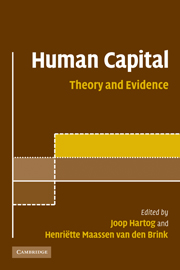Book contents
- Frontmatter
- Contents
- List of figures
- List of tables
- Notes on contributors
- Prologue
- Part I Measuring the benefits from human capital
- 1 What should you know about the private returns to education?
- 2 The social returns to education
- 3 Returns to training
- 4 Human capital and entrepreneurs
- 5 The effects of education on health
- 6 Are successful parents the secret to success?
- Part II Applying and extending the human capital model
- Part III Policy interventions
- Epilogue: some reflections on educational policies
- A note on econometrics
- Index
- References
1 - What should you know about the private returns to education?
Published online by Cambridge University Press: 22 September 2009
- Frontmatter
- Contents
- List of figures
- List of tables
- Notes on contributors
- Prologue
- Part I Measuring the benefits from human capital
- 1 What should you know about the private returns to education?
- 2 The social returns to education
- 3 Returns to training
- 4 Human capital and entrepreneurs
- 5 The effects of education on health
- 6 Are successful parents the secret to success?
- Part II Applying and extending the human capital model
- Part III Policy interventions
- Epilogue: some reflections on educational policies
- A note on econometrics
- Index
- References
Summary
Basic schooling model
In this chapter, we focus on schooling as an investment in human capital. We present the core model in its most basic specification and derive implications for interpreting wage differentials by education as reflecting returns on the schooling investment. We briefly survey international evidence on estimated private rates of return and summarize our own contributions to that literature
The basic human capital model of schooling envisages two options: (1) go to school for s years and earn an income Ys every year after leaving school, or (2) go to work right away and earn annual income Y0 (see figure 1.1). This makes the choice for schooling an investment problem. While in school, the student has forgone earnings of Y0 for every year in school and direct outlays for tuition, books, etc. of K per year. After leaving school the individual has benefits: in every working year, earnings are Ys rather than Y0. The gap in annual earnings is the dividend flowing on his investments.
The internal rate of return is the discount rate that equates the present values of the two lifetime earnings flows. But as the above suggests, we can also take it as the dividend rate Ys − Y0 relative to the investment cost, composed of forgone earnings Y0 and direct outlays K for every year in school.
- Type
- Chapter
- Information
- Human CapitalAdvances in Theory and Evidence, pp. 7 - 20Publisher: Cambridge University PressPrint publication year: 2007
References
- 12
- Cited by



